
Sometimes during the hustle and bustle of everyday life, stress runs high and self-care low. We worry about our families and our work. Yet, we manage to complete our to-do lists and care for our families. From the outside, we seem calm and put together.
Does this sound familiar? If this sounds like you, you might be dealing with high-functioning anxiety. This means you experience the symptoms of anxiety, including feelings of fear, unease or worry, but they don’t keep you from fulfilling your daily demands.
While high-functioning anxiety is not recognized as a clinical disorder, the toll of chronic stress and worries can come at a cost to your overall well-being.
So how do you know if the level of anxiety you feel is “normal,” and how can you keep it under control?
Recognizing high-functioning anxiety
A certain amount of anxiety in life is normal and motivates us to get things done. The trick is maintaining a healthy balance between energy and motivation. Often, people with high-functioning anxiety perform very well in work and school. They appear calm and keep their worries to themselves. And while these high achievers are deemed successful by society, they often report that they worry something bad is going to happen or that people will think badly of them if they fail or fall below expectations.
What high-functioning anxiety can look and feel like
On the surface, those with high-functioning anxiety can appear to be:
- Perfectionists
- Punctual, if not early
- Highly organized
- Overachievers
- Detail-oriented
- Proactive
Below the surface, they often struggle with:
- Overthinking/overanalyzing
- Fear of disappointing or angering others
- Self-doubt
- Obsessively double-checking details
- Racing thoughts
- Inability to relax
When worrying becomes a bigger issue
Everyone’s ability to deal with stress is different. When your anxiety interferes with carrying out everyday activities, it has become severe and impairing and it is time to seek medical help.
If you’re experiencing excessive worry coupled with changes in eating and sleeping pattern, feelings of dread, lack of concentration, racing thoughts, nausea, hot flashes or dizziness, your high-functioning anxiety might have crossed over into a diagnosable anxiety disorder.
When this happens, your anxiety is no longer a useful tool, but a hindrance to your health and well-being. If left untreated, high-functioning anxiety can lead to:
- Generalized anxiety disorder: Experiencing excessive anxiety and worry more days than not for at least six months. Generalized anxiety disorder interferes with your ability to function and complete tasks.
- Social anxiety disorder: Constant fear that what you do or say will be criticized or scrutinized by others. This leads you to avoid social gatherings.
- Major depressive disorder: Persistent feelings of sadness or a sense of worthlessness that can make you lose interest in regular activities.
- Obsessive-compulsive disorder: Chronic and uncontrollable recurring thoughts or repetitive behaviors that feel excessive, intrusive, and unreasonable.
How to manage high-functioning anxiety
Monitor your symptoms: Often individuals with high-functioning anxiety don’t recognize the connection between their symptoms and their chronic stress. Watch for symptoms like chronic headaches, upset stomach, trouble sleeping or mood changes. If you develop thoughts like ‘This is too stressful’ or ‘I just can’t handle this anymore,’ that is a red flag and a sign to reach out and get care.
Weigh the pros and cons of your decisions. You might feel as though you have no control of your situation, but you do! Talk through your options and their potential impact, so you can recognize your choices. Consider how your decision will impact your wellbeing.
Set realistic guardrails. To keep your stress in check, set realistic guardrails. Create a situation where you can succeed, instead of adding unnecessary pressure. For example, if there are concerns that take up a lot of your thoughts during the day, schedule a specific “time to worry” when you can make plans to help address those concerns. While this won’t get rid of the worrying, it will help limit the amount of time you lose each day.
When to seek professional help
Be proactive with your mental health. Too often, we don’t seek the help we need. In fact, an estimated 31% of Americans will experience an anxiety disorder during their lifetime, but only a third will receive treatment.
Work with a mental health professional to build awareness of your anxiety and explore different types of therapies. A psychiatrist can help determine if medication should be part of your treatment.
Remember that your mental health is vital to your overall well-being. While many of us find it easy to care for others, we lack empathy for ourselves. Make yourself a priority. Eat, sleep and exercise will help you navigate important preparations more effectively and with a calmer mind.